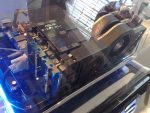So you’ve just bought a fancy new gaming PC and are looking to enhance your frame rates. Maybe you’re thinking a second graphics card in SLI or CrossFire will do the trick.
Multi-GPU setups have been around for the better part of 20 years now. While they can improve performance, they have major drawbacks as well.
If you’re thinking about taking the plunge, it’s a good idea to know how they work, and how they don’t.
How do SLI and CrossFire Work?
SLI and CrossFire work by taking two GPUs and splitting the workload that would normally be allocated to one. There’s a couple of different ways to do this.
Split frame rendering splits the screen in half with one graphics card rendering the top portion, and the other the bottom. Modern GPUs do this dynamically by analysing the image and splitting the workload evenly.
Alternate frame rendering is just what it sounds like. One card renders a full frame, the second card renders the next. Back and forth. This is generally the most efficient, and most common method used today.
In order to stay in sync with each other, both graphics cards need to be physically linked. Usually with a ribbon connector, but sometimes through the motherboard. You’ll also need a motherboard that supports two 16x size PCI Express slots.
How to pick graphics cards for SLI and CrossFire
Nvidia’s SLI requires both cards to be the same model number. If you have a GTX 1080 and want to run a second card, you have to buy another GTX 1080. Aside from that, the manufacturer or clock speed of the specific cards don’t really matter. In cases where one card is faster or has more memory than the other, the faster card will always run at the same speed and use the same memory as the slower one.
AMD’s CrossFire is a little different. You can freely mix and match cards of different models. If you wanted to pair up an RX 480 with a cheap RX 460, you can. You can even pair it up with your onboard graphics if you’re running an AMD APU. The only caveat is that both cards must be in the same generation. You can’t pair up an RX 480 with an R9 380 for example.
SLI and Crossfire Misconceptions
SLI or CrossFire double performance:
While using a multi-GPU setup can increase performance, it doesn’t scale up the way most people think. A good rule of thumb is a 50% gain over a single card. However, this can vary widely depending on how an application was coded. Some games perform better than others.
SLI and CrossFire doubles VRAM:
This one’s a bit counter intuitive. You’d think two 4GB cards in SLI or CrossFire would mean you now have 8GB of VRAM. Unfortunately, it doesn’t work that way. In order to stay in sync, the data in the RAM buffer is mirrored to each card. That way they’re always working with the exact same set of information. SLI and CrossFire bridges also aren’t fast enough to share data between the two cards to allow them to access each others memory. So the maximum amount of usable VRAM will remain at 4GB, or whatever amount the lower end card has.
SLI and CrossFire disadvantages
Poor Performance in some games:
As mentioned above, how a game performs in SLI or CrossFire depends largely on how the developer coded it. Some poorly optimised games may actually run worse under multi-GPU setups than they would with a single card. Others, especially older games, may not work at all.
Micro-Stuttering:
Most multi-GPU setups use alternate frame rendering. However, this can cause a problem called micro-stuttering. If one frame is more complex than the previous one, the second GPU has to work harder, and takes longer to render it. This causes the cards to become out of sync with each other, causing minor but noticeable stutters. GPU manufacturers will use something called “frame pacing” to limit it. This smooths out jarring variations in frame rate, but can reduce overall performance.
Higher Power Consumption:
Graphics cards are power hungry beasts. Adding a second card doubles up the amount of juice your computer’s power supply needs to deliver. You may need to buy a larger wattage PSU if you plan on using more than one card.
Heat & Cooling Issues:
Since multi-GPU setups require double the power, they also output double the heat. This can cause problems if you live in a hot country, using a high end gaming laptop, or don’t have adequate case cooling. If the cards become too hot, they may throttle clock speeds, reducing overall performance. They can also make your game room uncomfortably hot.
So why get an SLI or CrossFire setup?
You may be thinking, “great, SLI and CrossFire have some big drawbacks and might not even deliver the performance I crave. Mike, why they heck would I want one?”
Well, if you’re the average PC gamer, you don’t Get the best single graphics card you can afford, and leave it at that. It’ll save you a lot of headaches. However, SLI and CrossFire are useful if you really want to push the envelop of gaming.
4K setups for example still need a lot of horsepower. Very few single cards today can play games at 2160p while reliably hitting 60fps. Same goes for multi-monitor setups with big horizontal resolutions. Gamers might be interested in running a pair of GTX 1080s or GTX Titans in SLI if they want to ensure the best frame rate at UHD resolutions.
SLI and CrossFire can also be useful if you’re just trying to get the best fidelity and the fastest frame rates as possible. Or just want to muck about with the more exotic aspects of PC gaming.
If you chose to go with an SLI or CrossFire setup, just keep the caveats in mind. Otherwise, you’re better off saving your money to buy more games.





